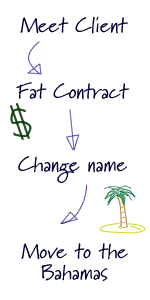You Should Work in a Web Factory
I work in a web factory. It’s not a real factory. It’s just a metaphor. Bear with me.
In a real factory, a company develops a process for creating a product. The process helps minimize variance, establish quality controls, comply with requirements, and ensure measurability. Once you have a process, you can tweak that process to get the results you want – bigger profits, shorter timelines, better product, etc. Web projects are a pain in the ass. They’re full of uncertainty, changing requirements, and an industry that doesn’t have it together. The solution: a solid process. Unfortunately, creative projects do not always lend themselves to factory-like precision. That’s OK. I’ll show you why and how to establish your process and follow it.
How to create your web development process
You probably already have something of a process in place. Projects don’t all happen at once, like some huge sneeze. They happen in stages. Begin by looking at those stages.
A common process for websites follows a “design, build, content” model. Let’s start with that (even though it’s not what I do). First, it’s not detailed enough. There are a lot of steps that such a simplified list ignores, probably because it’s easy to take them for granted. But if we don’t include them here, we might forget them. Or if something comes up, we might let them slide. A successful factory doesn’t skip steps just because something comes up.
That same three-step process might actually break down into this:
- Client Contact
- Proposal
- Initial Deposit
- Client Survey
- Research
- Design
- Approval
- Development
- Testing
- Content Integration
- Testing
- Approval
- Deployment
- Payment
It can get a lot more detailed, too. The more detailed the plan, the more likely you are to catch yourself when the project strays. You’ll spot variances while they’re happening, not at the end of the project.
I split design into research, design, and approval. I split development into development, testing, and deployment. I added a bunch of items that weren’t even accounted for in the simple version.
Now consider these new steps. Some of these aren’t website tasks at all! They’re business tasks. That’s because if a web business doesn’t have the business part down, the web part won’t work. Many web firms produce great work and then wait for months to get paid. The proposal phase is a holdup, too – getting new business seems to be a slow, frustrating process that often ends in mixed expectations and dissatisfaction. Make business a part of your process and it will become natural.
Fringe Benefits
One great benefit to having a solid process is that you can manage your client’s expectations. When the client knows what’s next (and what’s expected of him) you can manage the project more efficiently and effectively. If nobody knows what’s next, nothing will ever happen.
Another nice side effect is that a detailed process can help you estimate time and budget for each. If you’re used to estimating off the top of your head, you’d be surprised at how little you’re accounting for when you price your work.
Earlier, I mentioned that this process isn’t what I do. The main differences is that I have things rearranged. I have more detail in my process. Each step can be broken down further. For instance, the design phase actually includes an initial design meeting, mockups, and a series of revisions before the design approval. I also have more content steps (which come before design). There’s a content audit at the beginning, information architecture, content collection, and editing. I have these right before the design meeting, with some overlap.
The Ideal Project Process

Managing Your Process
For complex projects, the process may not be as linear. It’s more likely that you’ll have overlap (content and design running concurrently) and loops (like design revisions). But it’s important to adhere to this. Many failures are a result of straying from your tried and true process. When clients sign off on a step such as design, make sure they understand that any changes after that will be very costly to the project. Every project will test your devotion to the process.
What if the process isn’t working? You’ll know when your process is working because projects will run smoothly. It will feel more natural and make more sense. Ask yourself whether the project is fitting into your process or if you’re creating the process to fit the project? If you’re getting resistance, things are taking longer, or the client is unhappy, you may need to adjust. It’s your process: tailor it to your specific work.
A process isn’t meant to take away the creative, free-flowing agility that gives small web firms their life. It’s to minimize the effort spent on the repetitive actions, eliminate redundancies, and increase efficiency. It pays off for you, your client, and your product. At the end of the day, your process is supposed to make you more successful.
1 Comment
William H. Harle Jr. — January 18, 2007
So will we be implementing the ideal project process at NDWG soon? I could really use a tan.